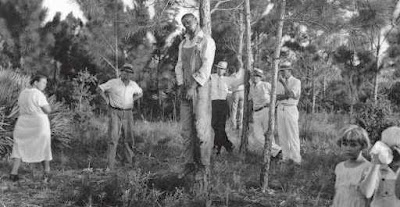
譯者:張戟
A Lynching Memorial Unveiled in Duluth
紐約時報
發表時間:二〇〇三年十二月五日
The New York Times
Published: December 5, 2003
國家處理惡夢的方式和人們處理惡夢的方式是一樣的--那就是試圖忘記他們。在美國,直到最近,在那些公眾記憶已經淡忘了的惡夢中,沒有比這個國家從1880年至1930年的種族恐怖運動更加的陰森可怕--成千上萬的黑人被吊死,被肢解,被活活燒死或拖到死,而大批遊人觀看。
Nations deal with nightmares the same way people do -- by trying to forget them. Among the nightmares that had faded from public memory in the United States until recently, none are more ghastly than the campaign of racial terror that gripped this country from the 1880's to the 1930's, when thousands of black Americans were hanged, mutilated, burned alive or dragged to death while huge crowds looked on.
這些事件有時也被稱為“私刑蜜蜂”或“黑人烤肉”, 是以一種可怕的嘉年華會的形式,吸引人潮帶著兒童和野餐的食物,從幾英裏之外趕來。受害者的屍體被拍照成明信片,作為恐嚇工具,直到郵寄這種明信片在20世紀初被禁止。私刑,不是總是偶發的暴力。有時是由白人導演的半官方的暴力,他們擔心新興黑人企業家的商業競爭,和仇視那些黑人記者號召性的報紙,這些報紙在第一次世界大戰前後開始緊迫而積極地為黑人爭取全部的公民權。
Sometimes called ''lynching bees'' or ''Negro barbecues,'' these events were cast as macabre carnivals, which drew crowds with children and picnic baskets from miles around. The victims' bodies were sometimes photographed for postcards, which were used as instruments of terror until mailing such postcards was barred in the early 20th century. Lynching was not always just random violence. It was sometimes semiofficial violence, directed by whites who feared business competition from emerging black entrepreneurs and who hated the crusading newspapers of the Negro press, which began pressing aggressively for full citizenship for black people around World War I.
知道這段期間這種暴力的美國人,傾向於認為這隻局限於種族隔離的南部。但事實上,這種私刑發生在該國許多地方。最近在明尼蘇達州北部城市德盧斯市推出的移動紀念館強調了這種暴力的普遍性,這個紀念館用以紀念在這期間死亡的三名年輕的黑人男子,埃爾默-傑克遜,埃利亞斯-克萊頓和以掃-麥克基,他們的私刑是在1920年的德盧斯,有10000名暴徒觀看。
Americans who know of the violence of this period at all tend to believe that it was confined to the segregationist South. But the fact that lynchings took place in many parts of the country was underscored recently in the northern Minnesota city of Duluth when the city unveiled a moving memorial commemorating the deaths of Elmer Jackson, Elias Clayton and Isaac McGhie, three young black men who were lynched in Duluth in 1920 while a mob of 10,000 looked on.
這個紀念館吸引了全國各地成千上萬的人。激情的高潮來自華倫-雷德的演講,雷德先生是華盛頓州的一位四年級的老師,他在研究家族史時發現他的高曾祖父曾協助領導那些衝進當地監獄的暴民,並把那三名黑人男子從各自的牢房裏帶走,這三位黑人男子原是馬戲班的工人。他的聲音哽咽感慨,他向死難者和他們的家人道歉。
The dedication drew thousands of people from all over the area. The emotional high point came with a speech by Warren Read, a fourth-grade teacher from Kingston, Wash., who had learned while researching his family that his great-grandfather had helped lead the mob that stormed the local jail and took the three men, who were circus workers, from their cells. His voice choking with emotion, he apologized to the victims and their families.
在德盧斯的紀念館是開始於20世紀90年代民族之旅的一部分,學者們和眾多的博物館開始揭開一個可恥的和可怕的時期的遮羞布。經過近一個半世紀的轉折,這個國家現在似乎作好了準備來正視自己那段不堪回首的噩夢。
The memorial in Duluth is part of a national journey that began in the 1990's, when scholars and museums began to pull back the covers on a shameful and horrific period. After nearly a half-century of turning away, the country now seems more ready to look its nightmare squarely in the eye.
1935 lynching of Rubin Stacy in Fort Lauderdale, Florida
湖邊草亭
(C)Copyright Reserved
正文
私刑紀念館在德盧斯揭幕
評論
博主已隱藏評論
博主已關閉評論




